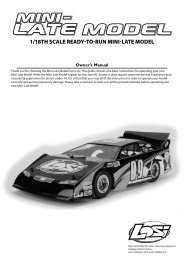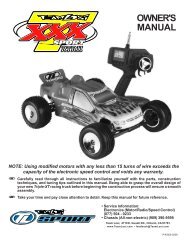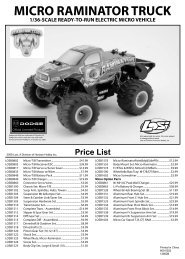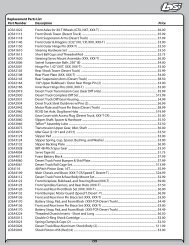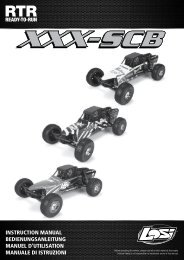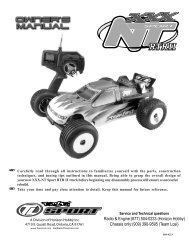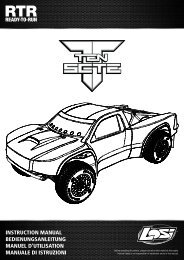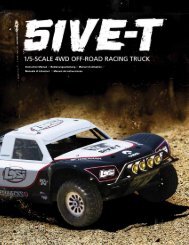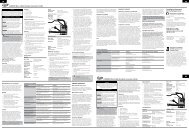Create successful ePaper yourself
Turn your PDF publications into a flip-book with our unique Google optimized e-Paper software.
SETUP GUIDETIPS AND HINTS FROM THE TEAMBefore you start making changes on your 8IGHT <strong>2.0</strong> Off-Road Racing buggy, you need to make a few decisions. First of all, tires, and how they are setup, have a tremendous impact on overall performance. Before you start making changes on the chassis setup, take a moment to observe a few of thefastest cars at the track and what type of tire and inner liner they are running. You will find the best adjustment will become a personal decision basedon the “feel” that each of these adjustments yield. Never make more than one change at a time; if the change you made works adversely, or doesn’taddress your need, return to the previous position and try something else. Team <strong>Losi</strong> Racing development team has put hundreds of hours on the8IGHT <strong>2.0</strong> to arrive at the setup we put in the instruction manual. If you find that you have lost the “handle” go back to the vehicle (stock) setup, as thissetup has proven to be reliable, consistent and easy to drive.All of us at <strong>Losi</strong> are sure that you will find the 8IGHT <strong>2.0</strong> Off-Road Racing Buggy to be the most versatile and easiest car to drive fast, with greatconsistency. We hope the information in the following guide helps you to enjoy your 8IGHT <strong>2.0</strong>, and racing it, as much as we do. For the latest in setupand accessory parts information, visit the <strong>Losi</strong> web site at: www.losi.com regularly. Please check the <strong>Losi</strong> web site periodically to find out new setupinformation as we are always testing on all types of tracks and surfaces. Also note that there are many ways to set up a car. The rules we follow canreverse sometimes with different driving styles or different setup styles, so test for yourself and you will find a set up that works right for you.Tuning the Engine:Should be done following the manufacturer's instructions. Turning the needle valve clockwise, the fuel mixture will become leaner – meaning thatthe engine will draw less fuel. When the needle valve is turned counterclockwise, the fuel mixture becomes richer, meaning that, the engine will drawmore fuel. The high speed needle affects the fuel mixture at fuel throttle while the low speed needle only affects the fuel mixture at idle and the lowend of the throttle band. Our recommended engine and pipe combo for your Team <strong>Losi</strong> Racing 8IGHT <strong>2.0</strong> is the GRP Mario Rossi tuned .21 engine andGRP 2053 Pipe.To Shut Off the Engine:Simply use the included pipe plug or simply bump the flywheel with a wrench or plastic handled tool. <strong>Losi</strong> also makes a tuning driver with a built-inplug for the pipe (LOSA99167).The Receiver Battery:The receiver battery is an important, frequently overlooked part of gas-powered vehicles. A low receiver battery can cause the vehicle to have amind of its own. The result can be runaway vehicle or a poorly responding radio system. The length of time that a receiver battery pack’s charge lastsdepends on the type of servos that are used. If you will be using a NiCd or NiMH receiver pack, it is recommended that a minimum battery size of1100mAh and minimum voltage of 5.4 volts be used. Recommended batteries that are offered by <strong>Losi</strong> are LOSB9950 6V 1100mAh NiMH ReceiverPack or LOSB9820 7.4V 2000mAh 2C LiPo Receiver Pack. Please note that a voltage regulator will be needed if you choose to use a Lithium Polymer(LiPo) receiver pack. <strong>Losi</strong> offers voltage regulators with a switch, LOSB9608 and without a switch, LOSB9609.Droop:Always measure the droop of the 8IGHT <strong>2.0</strong> with the shocks on the buggy. Droop is always measured from the center of the top shock mount to thecenter of the bottom shock screw. More droop (travel) in the front will have more on-power steering and allow the buggy to roll more on the rearwhen on throttle. More droop (travel) in the rear will increase off-power steering and allow the buggy to roll on the front when off throttle. More frontand rear droop will accelerate better in bumps when going straight, but can cause the buggy to traction roll in rough turns. Less front and rear droopwill slide over bumps better in turns and may be better on high-speed and high-traction tracks.Front Camber Links:The lower camber link locations on the tower have more camber gain (total camber change through the suspension travel). Running the cambertie rod in the lower holes will increase off-power steering and make the vehicle more aggressive; however you may lose some consistency. Morecamber gain is good on small tight tracks. We have found that running less camber gain in the front suits the car the best for consistency and steeringbalance. On the 8IGHT <strong>2.0</strong> we offer a longer camber link on the spindle carrier. A longer front camber link will make the vehicle feel stiffer and this willkeep the buggy flatter with less roll and increase high-speed steering. A short front camber link will roll more and make the vehicle more aggressive.Too short of a front link may make the vehicle feel twitchy.Rear Camber Links:The 8IGHT <strong>2.0</strong> now has only three camber locations on the rear tower, however, we have added another inside hole on the rear hub. The stockcamber link setup for the 8IGHT <strong>2.0</strong> is location #2 on the tower and B in the hub. By using a longer rear camber link you will have less roll andimprove stability and traction. A shorter rear camber link will have more roll and increase steering and better handling in the bumps. Running “A” inthe rear hub will generate more corner rotation entering the turn, but decrease steering on exit. Running “B” in the hub will be more stable enteringthe turn and increase steering on exit.Pistons:Generally smaller hole pistons, #56, have stiffer damping, slower weight transfer, slower response, and will land large jumps better. Larger holepistons, #54, have softer damping, increased traction, quicker weight transfer/response, and bottom out easier off large jumps.Shock Oil:Lighter shock oil has more overall traction and responds quicker. Thicker oil has less overall traction and reacts slower. On high bite/smooth tracks,thicker oil is easier to drive. Make sure you adjust oil when there is a drastic temperature change (20-25 degrees). If it gets cold outside you need to goto lighter shock oil. If it gets hotter outside you need to go to thicker weight shock oil.Front Toe:You never want to run toe-in on the front of the 8IGHT <strong>2.0</strong>. Front toe-in (longer steering rods) decreases steering response entering and in the middleof the turn but will increase on power steering. Toe-out (shorter steering rods) increases steering response when entering the turn and increasesstraight line stability, however, it will decrease on power steering.37



